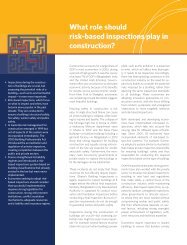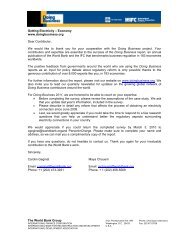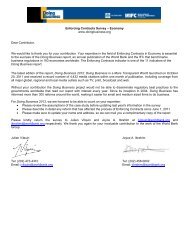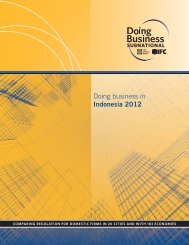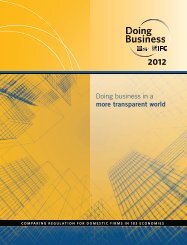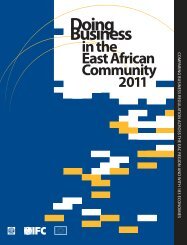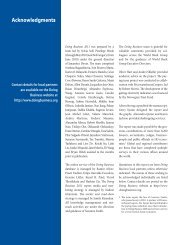Economy Profile: Burundi - Doing Business
Economy Profile: Burundi - Doing Business
Economy Profile: Burundi - Doing Business
Create successful ePaper yourself
Turn your PDF publications into a flip-book with our unique Google optimized e-Paper software.
<strong>Doing</strong> <strong>Business</strong> 2013<br />
<strong>Burundi</strong><br />
108<br />
DATA NOTES<br />
The indicators presented and analyzed in <strong>Doing</strong><br />
<strong>Business</strong> measure business regulation and the<br />
protection of property rights—and their effect on<br />
businesses, especially small and medium-size domestic<br />
firms. First, the indicators document the complexity of<br />
regulation, such as the number of procedures to start a<br />
business or to register and transfer commercial<br />
property. Second, they gauge the time and cost of<br />
achieving a regulatory goal or complying with<br />
regulation, such as the time and cost to enforce a<br />
contract, go through bankruptcy or trade across<br />
borders. Third, they measure the extent of legal<br />
protections of property, for example, the protections<br />
of investors against looting by company directors or<br />
the range of assets that can be used as collateral<br />
according to secured transactions laws. Fourth, a set of<br />
indicators documents the tax burden on businesses.<br />
Finally, a set of data covers different aspects of<br />
employment regulation.<br />
The data for all sets of indicators in <strong>Doing</strong> <strong>Business</strong><br />
2013 are for June 2012. 2<br />
Methodology<br />
The <strong>Doing</strong> <strong>Business</strong> data are collected in a<br />
standardized way. To start, the <strong>Doing</strong> <strong>Business</strong> team,<br />
with academic advisers, designs a questionnaire. The<br />
questionnaire uses a simple business case to ensure<br />
comparability across economies and over time—with<br />
assumptions about the legal form of the business, its<br />
size, its location and the nature of its operations.<br />
Questionnaires are administered through more than<br />
9,600 local experts, including lawyers, business<br />
consultants, accountants, freight forwarders,<br />
government officials and other professionals routinely<br />
administering or advising on legal and regulatory<br />
requirements. These experts have several rounds of<br />
interaction with the <strong>Doing</strong> <strong>Business</strong> team, involving<br />
conference calls, written correspondence and visits by<br />
the team. For <strong>Doing</strong> <strong>Business</strong> 2013 team members<br />
visited 24 economies to verify data and recruit<br />
respondents. The data from questionnaires are<br />
subjected to numerous rounds of verification, leading<br />
to revisions or expansions of the information collected.<br />
2 The data for paying taxes refer to January – December 2011.<br />
ECONOMY CHARACTERISTICS<br />
Gross national income per capita<br />
<strong>Doing</strong> <strong>Business</strong> 2013 reports 2011 income per capita<br />
as published in the World Bank’s World Development<br />
Indicators 2012. Income is calculated using the Atlas<br />
method (current US$). For cost indicators expressed<br />
as a percentage of income per capita, 2011 gross<br />
national income (GNI) in U.S. dollars is used as the<br />
denominator. GNI data were not available from the<br />
World Bank for Afghanistan; Australia; The Bahamas;<br />
Bahrain; Barbados; Brunei Darussalam; Cyprus;<br />
Djibouti; Guyana; the Islamic Republic of Iran;<br />
Kuwait; Malta; New Zealand; Oman; Puerto Rico<br />
(territory of the United States); Sudan; Suriname; the<br />
Syrian Arab Republic; Timor-Leste; West Bank and<br />
Gaza; and the Republic of Yemen. In these cases<br />
GDP or GNP per capita data and growth rates from<br />
the International Monetary Fund’s World Economic<br />
Outlook database and the Economist Intelligence<br />
Unit were used.<br />
Region and income group<br />
<strong>Doing</strong> <strong>Business</strong> uses the World Bank regional and<br />
income group classifications, available at<br />
http://data.worldbank.org/about/countryclassifications.<br />
The World Bank does not assign<br />
regional classifications to high-income economies.<br />
For the purpose of the <strong>Doing</strong> <strong>Business</strong> report, highincome<br />
OECD economies are assigned the “regional”<br />
classification OECD high income. Figures and tables<br />
presenting regional averages include economies<br />
from all income groups (low, lower middle, upper<br />
middle and high income).<br />
Population<br />
<strong>Doing</strong> <strong>Business</strong> 2013 reports midyear 2011<br />
population statistics as published in World<br />
Development Indicators 2012.<br />
The <strong>Doing</strong> <strong>Business</strong> methodology offers several<br />
advantages. It is transparent, using factual information<br />
about what laws and regulations say and allowing<br />
multiple interactions with local respondents to clarify<br />
potential misinterpretations of questions. Having



